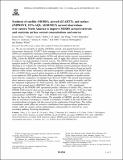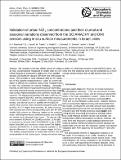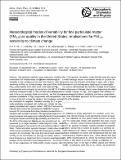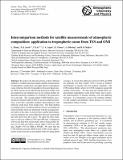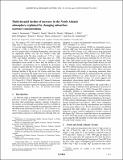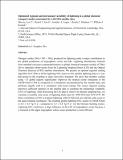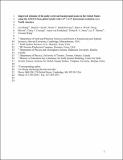Search
Now showing items 21-30 of 287
Synthesis of Satellite (MODIS), Aircraft (ICARTT), and Surface (IMPROVE, EPA-AQS, AERONET) Aerosol Observations over Eastern North America to Improve MODIS Aerosol Retrievals and Constrain Surface Aerosol Concentrations and Sources
(Wiley-Blackwell, 2010)
We use an ensemble of satellite (MODIS), aircraft, and ground-based aerosol observations during the ICARTT field campaign over eastern North America in summer 2004 to (1) examine the consistency between different aerosol ...
Validation of Urban \(NO_2\) Concentrations and Their Diurnal and Seasonal Variations Observed from the SCIAMACHY and OMI Sensors Using In Situ Surface Measurements in Israeli Cities
(European Geosciences Union, 2009)
We compare a full-year (2006) record of surface air \(NO_2\) concentrations measured in Israeli cities to coinciding retrievals of tropospheric \(NO_2\) columns from satellite sensors (SCIAMACHY aboard ENVISAT and OMI ...
Chemistry of Hydrogen Oxide Radicals \((HO_x)\) in the Arctic Troposphere in Spring
(European Geosciences Union, 2010)
We use observations from the April 2008 NASA ARCTAS aircraft campaign to the North American Arctic, interpreted with a global 3-D chemical transport model (GEOS-Chem), to better understand the sources and cycling of hydrogen ...
Meteorological Modes of Variability for Fine Particulate Matter (PM2.5) Air Quality in the United States: Implications for PM2.5 Sensitivity to Climate Change
(European Geosciences Union, 2012)
We applied a multiple linear regression model to understand the relationships of PM2.5 with meteorological variables in the contiguous US and from there to infer the sensitivity of PM2.5 to climate change. We used 2004–2008 ...
Intercomparison Methods for Satellite Measurements of Atmospheric Composition: Application to Tropospheric Ozone from TES and OMI
(European Geosciences Union, 2010)
We analyze the theoretical basis of three different methods to validate and intercompare satellite measurements of atmospheric composition, and apply them to tropospheric ozone retrievals from the Tropospheric Emission ...
Multi-Decadal Decline of Mercury in the North Atlantic Atmosphere Explained by Changing Subsurface Seawater Concentrations
(American Geophysical Union, 2012)
[1] We analyze 1977–2010 trends in atmospheric mercury (Hg) from 21 ship cruises over the North Atlantic (NA) and 15 over the South Atlantic (SA). We find a steep 1990–2009 decline of −0.046 ± 0.010 ng m−3 a−1 (−2.5% a−1) ...
Optimized regional and interannual variability of lightning in a global chemical transport model constrained by LIS/OTD satellite data
(Wiley-Blackwell, 2012)
Nitrogen oxides (NOx≡ NO + NO2) produced by lightning make a major contribution to the global production of tropospheric ozone and OH. Lightning distributions inferred from standard convective parameterizations in global ...
Improved estimate of the policy-relevant background ozone in the United States using the GEOS-Chem global model with 1/2° × 2/3° horizontal resolution over North America
(Elsevier BV, 2011)
The policy-relevant background (PRB) ozone is defined by the US Environmental Protection Agency (EPA) as the surface ozone concentration that would be present over the US in the absence of North American anthropogenic ...
Sources, distribution, and acidity of sulfate–ammonium aerosol in the Arctic in winter–spring
(Elsevier, 2011)
We use GEOS-Chem chemical transport model simulations of sulfate–ammonium aerosol data from the NASA ARCTAS and NOAA ARCPAC aircraft campaigns in the North American Arctic in April 2008, together with longer-term data from ...
Ozone air quality measurement requirements for a geostationary satellite mission
(Elsevier, 2011)
We conduct an Observing System Simulation Experiment (OSSE) to test the ability of geostationary satellite measurements of ozone in different spectral regions to constrain surface ozone concentrations through data assimilation. ...


